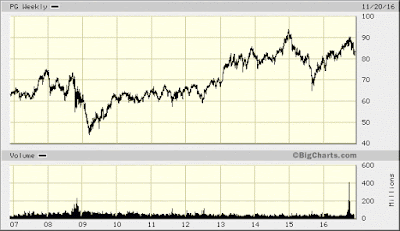The Procter & Gamble Co (NYSE:PG), together with its subsidiaries, manufactures and sells branded consumer packaged goods. The company operates through five segments: Beauty, Grooming, Health Care, Fabric Care and Home Care, and Baby Care and Family Care. This dividend king has paid dividends since 1891 and has managed to increase them for 60 years in a row.
The company’s latest dividend increase was announced in April 2016 when the Board of Directors approved a 1% increase (1) in the quarterly dividend to 66.95 cents/share. The company’s peer group includes Colgate-Palmolive Company (NYSE:CL), Kimberly Clark Corp (NYSE:KMB) and Unilever plc (ADR) (NYSE:UL).

LADO/Shutterstock.com
Over the past decade this dividend growth stock has delivered an annualized total return of 6%/year to its shareholders.
The company has managed to deliver an anemic 2.80% average increase in annual EPS over the past decade. Procter & Gamble is expected to earn $3.89 per share in 2017 and $4.21 per share in 2018. In comparison, the company earned $3.49/share in 2016.
Procter & Gamble also has managed to reduce the number of shares outstanding. Since the acquisition of Gillette closed in 2006, the number of shares declined from 3,286 million to 2,822 million in 2016.
The company strives to generate cost savings, tries to grow through innovation and through acquisitions, while carefully managing its cash flow in order to pay dividends and buy back stock consistently.
Procter & Gamble Co (NYSE:PG) also owns strong brand names, which allow it to maintain pricing power, in order to be able to pass price increases on to consumers. The company is the leader is segments such as blades and razors, feminine care, and baby products. Recent events included the shedding of over 100 brands, designed to allow management to be more focused on its best performing products. In addition, management is focused on lowering costs for the company.
The sheer scale of its massive operations and broad geographic reach ensure that the company is able to generate consistent revenue streams. Its scale, diversity of products, and the fact that it’s a leader in most of its categories with a global reach are definite advantages, which is why I believe the company to have a wide moat. When you have scale, per unit costs for your products are lower than competitors.
The company might have stumbled as of the past few years, as evident by the lack of much earnings per share growth (2) since 2008. The company lost a little bit of focus, and needs to keep driving innovation and win more consumers to engage in repeated purchases of its products. The risk to it includes consumers looking for more value, and switching to cheaper alternatives. The new Procter & Gamble would be nimbler, and more focused on a smaller number of brands.
Follow Procter & Gamble Co (NYSE:PG)
Follow Procter & Gamble Co (NYSE:PG)
The annual dividend payment has increased by 8.70% per year over the past decade, which is higher than the growth in EPS. Given the increase in the dividend payout ratio, and lack of earnings growth over the past decade, I expect anemic dividend growth going forward.
Since 1970 Procter & Gamble Co (NYSE:PG) has actually managed to double dividends every five years on average. It is quite possible that Procter & Gamble’s dividend streak comes to an end, if earnings growth cannot be restarted.
In the past decade, the dividend payout ratio increased from 42.10% in 2007 to 76.20% in 2016. A lower payout is always a plus, since it leaves room for consistent dividend growth, minimizing the impact of short-term fluctuations in earnings.
The return on equity has remained stable between 13% to 18%. Rather than focus on absolute values for this indicator, I generally want to see at least a stable return on equity over time.
Currently, the stock is overvalued at 21.40-times forward earnings and yields 3.20%. Given the lack of earnings growth over the past decade, the high payout ratio, and the high valuation, I am not interested in the company. If I were starting out today, I would not be initiating a position in the stock.
I am holding on to my shares for the time being because it is possible that the company may turn around operations over the next decade, emerging markets turn hot again, and the dollar weakens ( which would make international sales more valuable).
My investment record has shown me that I make a mistake in 80% – 90% of the situations where I have sold an investments for any reason, and bought something else with the proceeds. The original investment turns around its operations and rewards its patient investors, whereas the new investment starts experiencing troubles. In addition to that, if I were to sell Procter & Gamble, I would also have to pay a significant amount to the tax man on the realization of long-term capital gains.
That being said, I am allocating my P&G dividends elsewhere (3). I am trying to become as passive as an investor as possible, and let my collection of businesses do their job, without micromanaging them. If P&G cuts dividends however, I would be out one second after the announcement.
Full Disclosure: Long PG, UL, KMB, CL
Additional Links:
(1) http://www.dividendgrowthinvestor.com/2016/04/procter-gamble-raises-dividends-for.html
(2) http://www.dividendgrowthinvestor.com/2015/06/the-most-important-metric-for-dividend.html
(3) http://www.dividendgrowthinvestor.com/2009/07/reinvest-dividends-selectively.html










